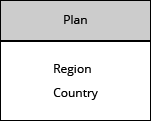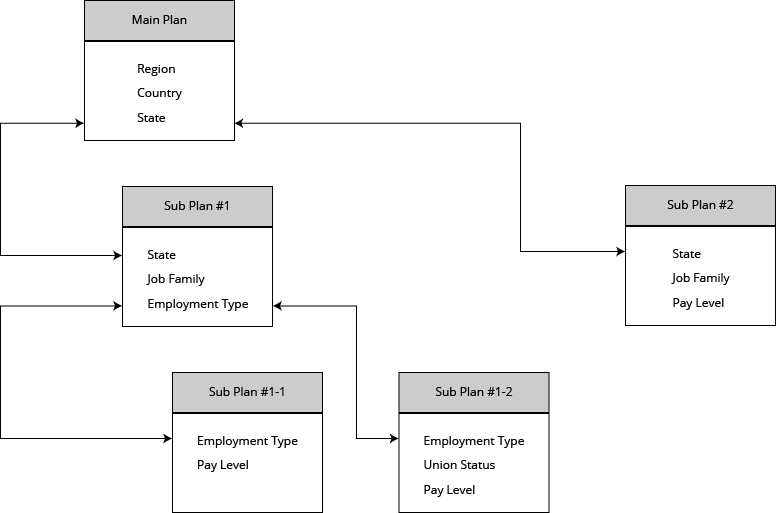Planning Best Practices
Learn more about the planning process and best practices to maintain plan performance.
Member key vs member name
Member names change frequently as they are updated to reflect the current naming conventions. For example, job names and department names change quite frequently. However the name changes do not affect the underlying unique keys, as organizations want to be able to track and compare information from historical periods for the same member, even if the name has changed over time. This is true for planning as well the stability of these member keys are a much better method to plan against, rather than the changing names. By utilizing the member keys, reconciliation of data will only need to be performed when there is truly a new addition of a member or the deletion of a member and not just a name change.
Plans and subplans
All planning information can be contained in a single large plan or a set of linked plans, both methods capture the same planning information, but the linked plans will have many advantages over the single large plan. Advantages include performance, manageability, security, flexibility in planning structure, and greater efficiency during collaboration.
Single plan

Linked plans

The main plan is considered the “master” plan, it contains all of the summary aggregate values that are most important to the executive stakeholders of your company and used for strategic decision making. The linked subplans on the other hand are the supporting details that each of the line of business or locations, that are managed and maintained by each of the respective owners. These more detailed subplans are used to understand the operational requirements.
The number of linked plans will vary between organizations. Some organizations will have only a main plan or a main plan and a few subplans, while other organizations will have 3 or more linked plan levels. The main determinants for fewer linked plans are fewer contributors to the planning process and the complexity of the planning hierarchy.
Plan hierarchy
A planning hierarchy consists of one or more planning segments, it can be a cost center level, organizational level, location (region, country, state, etc), job family, employee type, contract type, etc. The planning hierarchy is defined by the planner to suit organizational needs and can be as simple as:

An example of a more complex planning hierarchy would be:

Performance considerations
The following factors will directly influence the performance of your plans and may require you to add additional linked plans to help you manage the planning processes:
- The number of levels within the plan
- The number of members within each level
- The number of periods within the plan
Plan hierarchy segments or levels
The greater the number of segments within the the planning hierarchy, the slower the plan will perform. A three level planning hierarchy will perform substantially faster than one that is 10 levels deep.
We recommend that the number of levels for each plan contains only the information needed. Keeping the planning hierarchy to fewer levels will ensure that your plans perform well throughout the planning process and help the planners and contributors navigate the planning hierarchy with greater efficiency, thus the effort to finding and updating plan values is greatly reduced. This does not mean that you will not be able to capture all of the information that is needed for both strategic and operational planning. By linking the plans, each contain successively more detail, the strategic and operational needs can be maintained.

Members
The number of members at each level also has a direct impact on performance. For example, the number of countries will be substantially less than the number of cities. Therefore, plans will be able to render and compute faster at a country level than at the city level. Another example would be planning on job family versus planning on job name, there are immensely more job names than there are job families.
The frequency of changes to members within the segment will also impact the amount of effort to maintain the plan throughout the planning process. Segments that change frequently for most companies will be supervisory hierarchy, organizational hierarchy, and job names. Segments that do not change frequently are cost center hierarchy, job family, and employment type. Imagine planning on a segment that changes often, such as the supervisory hierarchy, in January you plan to have 5 people report to a specific manager, but in February, that manager leaves the company and the 5 people reporting into the leaving manager needs to be reallocated to another manager for the plans to be up to date. For most companies supervisory changes occur frequently throughout the year and you would need a full time person just to maintain the plans data accuracy, with little to no benefit to the overall planning process. Planning on a segment that changes infrequently, such as the cost center, will allow the planners to concentrate on what is important to the organization: an accurate account of the number of people needed and the associated costs of the workforce.
Time periods
The number of time periods in your plan directly impacts performance. The more time periods you have, the greater number of projection computations will need to be performed, thus leading to slower performance. Planning in detail for 60 months will not only be slow, but inaccurate, as the conditions that exist today or in the past may not hold true five years from now. Organizations should actively plan for longer durations for their strategic decision making process. However, you need to understand the information needed to make these long term decisions and not to include more information than necessary. Capturing too much information only slows the planning process down, leading to fewer options that could be modeled and compared to understand the plan that best suits the corporation.
The amount of information that is contained within these strategic plans should be kept to a summary form, such as only the top two or three levels of the cost center hierarchy, as it also does not change frequently over a longer duration and thus requires less maintenance for future years. An organization that tries to plan in detail for 60 periods will end up spending more time and resources just to maintain the accuracy of these plans over time, rather than updating past assumptions, such as base pay and currency rates, to match the new business environment to understand the impacts, potentially saving the company millions of dollars in the process.
Stable planning segments
Stable planning segments allow the plan to be consistent over a longer timeframe. Imagine trying to plan on a set of values that changes every month. How would you be able to keep track of all these changes in the first place, let alone be able to move past plan headcount to the new member? Visier Planning allows you to reconcile the changes when they are detected. These changes may be the result of new members being added or deleted from the source system. The amount of reconciliation that will be required will be highly dependent on the segments chosen for the plans, the more stable the segments are from changes, the easier it will be to reconcile.
Segments that are known to have frequent changes are: Supervisory hierarchy, organizational hierarchy, and job name to list a few. Some examples of segments that are much more stable and are recommended for planning are: cost center hierarchy, job family and employment type to name.
Member additions
When new members are added to the source systems, these new members will have resources attached to them and thus planners will want to account and plan for these new members to have an accurate plan. These members may be a result of unplanned additions such as unanticipated new jobs that are needed to fulfill regulatory compliance requirements. Some members being added are planned, but did not exist during the planning process, as they will not materialize until a future time. For example, if a company is expanding into a new location, the planners will need to account for this new location, even though the location will not be operational until six months into the future. If the future location was not accounted for in the plan, the resource levels and costs would be underestimated.
Member deletions
Just as members can be added, they can also be deleted, requiring the planner to update the plans to reflect the deletions. For example, a company has a change in strategy and is closing a location, however there are current resources allocated to this location. The planner will need to understand how these deletions will need to be handled in order to update the plans. If the closure of the location results in a layoff of all the workers, the planner can delete the corresponding member from their plans. This also means that all of the planned resources will also be deleted. But if some of those employees will be relocated to other locations, these relocations will need to be allocated to a new location to retain an accurate plan.
